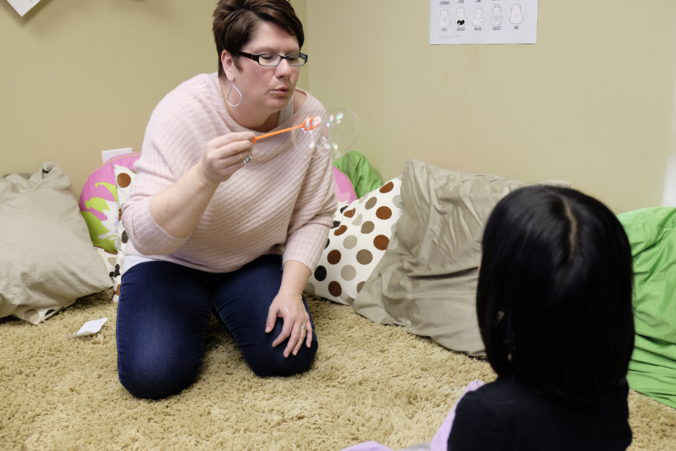
One of the most common struggles parents face is playing with their children. For some, it just doesn’t come natural to be playful with kids. Often, we are too heavy on structure or correction because it’s what we think our kids need. But what if it were possible to teach our kids certain needed skills WHILE playing and having fun with them?
All of the activities below will meet your kids’ needs in some capacity. They will also help break up those long, dreaded indoor days!

For younger children:
- Bring bubbles inside! Sit on your kitchen floor and have your little one try to pop the bubbles with a particular body part (elbows, toe, ear). Bubbles catch interest and you can make the activity more structured or more spontaneous! Eye contact, laughing and being silly together also helps build connection and strong attachment.
- Sticker match: Place colorful stickers on your child and then have the child place stickers on you in the same places until you are both decorated the same way. After all of the stickers are on, touch your matching stickers nose to nose, elbow to elbow, etc… This engaging activity will promote teamwork, laughing, matching and connecting.
- Trace messages or do a “weather report” on your child’s back. Write letters, pictures or messages on their back and have them guess what they are. Do a “weather report,” asking your child what the weather was like today. If it was warm and sunny, make a large, warm circle with your hand. For windy weather, you could swoop your hands lightly across their back and make a swishing noise. To create thunder, you could pound gently with the sides of your hands. And to create rain, make light finger taps. This activity can also help calm your child down if they need it, while having fun and meeting sensory needs.
For all ages:
- Balloon games: Work together to keep the balloon in the air without touching the ground and see how high you can get in. Change it up by trying to use only one body part like your head or elbow. Balloon races are fun for the whole family: get in partners and place a balloon between your heads or stomachs, working together to keep the balloon from falling. Set up a start line and finish line to see who can get there first. This activity promotes teamwork and cooperation, as well as connecting.
- Cotton ball hockey: Lie on the floor on your stomachs (or sit with a pillow in between you) and blow cotton balls back and forth, trying to get the cotton ball under your partner’s arms or off the edge of the pillow. Or make it more challenging by working together to keep the cotton ball on the pillow in the middle. This is an engagement activity that encourages teamwork and models regulation.
- Red Light, Green Light or Follow the Leader: These simple childhood games can help you share power with your kids by taking turns being the leader or being the “caller” for red light, green light. It also helps them learn how to regulate by having to wait for directions and to control their bodies.
- Thumb wrestling or Rock, Paper, Scissors: These super simple games promote touch, cooperation and eye contact with your child.
- Heads Up: This game can be downloaded as an app on your phone! There are even versions with just pictures so that younger kids can also play and give clues. One player holds the phone to their head and the other players try to get them to guess what the picture is on the phone by giving various clues. Once you guess the correct answer, you just tilt your head down to go to the next picture. If you need to pass, you tilt your head up! These games foster eye contact/bonding, cooperation and learning.
We didn’t forget about your teens!
- Manicures and pedicures: Take turns with your teen giving each other a manicure or pedicure (or both). This allows for nurturing time with healthy touch that doesn’t feel intrusive or overwhelming to your teen.
- Temporary tattoos: Find some fun tattoos that your teen might like. Allow them to choose one for you as well. Just remember, they’re temporary, and allowing your teen to choose empowers them and lets them know you are having fun.
- Progressive pass around: There are several ways to implement this activity. The idea is to take turns, building upon the activity as you go. You can do a silly face pass around in which the first person makes a silly face, then the next person repeats that face plus adds one of their own. This is repeated, going around the circle as many times as everyone wants to. You can also do this with writing a story. Each person takes a turn writing a sentence, making up a story as they go along. Lastly, you can play pass around by drawing pictures as well. Each person gets a turn drawing one thing on the paper. All of these activities foster connection and working together as well as strengthening creativity.
Pam Shepard | Supervisor of Clinical Services
*Most activities from Theraplay ® activities flip book

